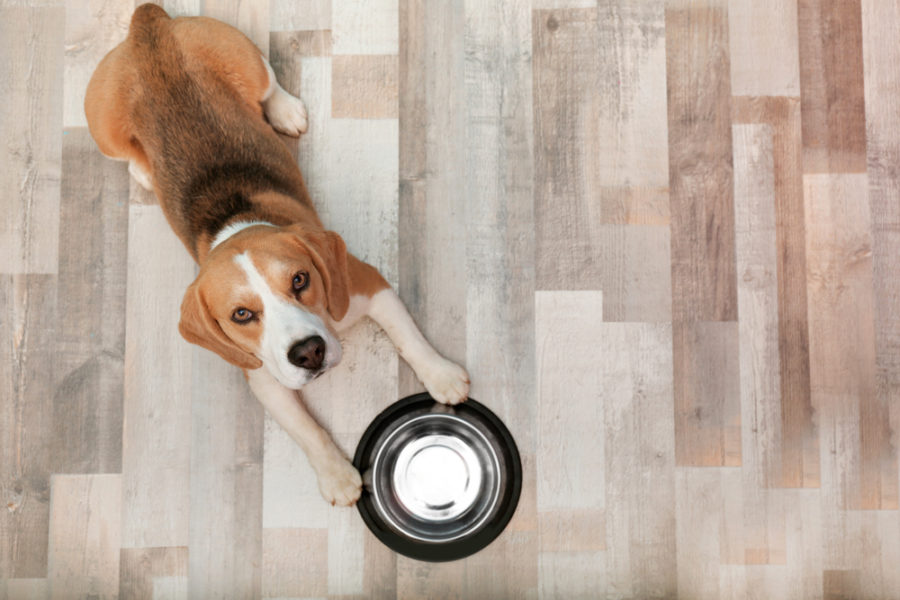Certain pet foods are more hydrating than others. Learn what to look for to ensure your animal companion is getting the right amount of nutrition and moisture from his diet.
Keeping your pet hydrated is an important factor in the maintenance of good health. While some dogs and cats are “good drinkers” – i.e., they take it upon themselves to drink water regularly without encouragement – others need a bit more help getting the fluids they require to thrive. If your companion falls in the latter category, switching him to a more hydrating diet is one measure you can take to ensure his H2O intake is where it should be. Here’s a few things to consider when shopping for a food that’s high in moisture – and nutrition!
Canned, kibble or raw?
With more and more food options popping up in the pet industry, choosing the best one for your pet can be overwhelming. But it doesn’t have to be! The first step is to decide what type of food you want to feed him – canned, kibble or raw. There are numerous factors to consider including ingredients, bio-availability and palatability. But when it comes to moisture content, kibble is at a significant disadvantage due to the way it’s cooked.
“Kibble is exposed to higher temperatures for a longer time and must be dried to remove any excess moisture on the surface and interior, hence the lower moisture content,” says Lindsay Tracy, Director of Product Development and New Business at Redbarn Pet Products. “Generally speaking, kibble may have around six to ten percent moisture; semi-moist food, like Redbarn’s Rolled Food, may have anywhere from 15 to 50, while canned food should be upward of 75 percent.”
Expert tip: If kibble is your only option due to time or financial constraints, Lindsay recommends using canned food as a topper to add moisture.
If you’re looking for a more hydrating diet for your pet, wet or canned food is a better option than kibble. Raw food is also a smart choice, but it’s important to abide by the package directions if you opt for a dehydrated or freeze dried raw brand. Because these diets have gone through processing to have the natural moisture removed, adding it back in is crucial. “You can determine how much water is in your pet’s food by looking at the percentage of moisture content found on the back of the nutrition label, under Guaranteed Analysis,” says Lindsay.
Choosing the right treats
If you suspect your pet isn’t consuming enough water, it’s important to take extra precautions to improve his hydration – and that means “treating” him right! When selecting treats for your dog or cat, take the same steps you do when selecting his food. “Some treats will also have a Guaranteed Analysis on the back of the bag or label,” says Lindsay. “Check the moisture percentage to see how much water is in the treat. You most likely won’t find anything packaged with a high percentage like canned food, but you can compare this number when deciding what treat to take home.”
Expert tip: Puppies need more water throughout the day compared to adults, so if you’re training a young canine, it’s even more important to make sure your food rewards of choice are hydrating.
Another option is to skip the traditional treats altogether, and use a high-moisture food as a way to reward him in between meals. For instance, Lindsay reports that many of their customers use Redbarn’s Rolled Food as a treat. “You can open it up, cut it into small cubes, and serve as a treat,” she says. “With a moisture content of 43 percent, it’s one of the best ways to keep your pup hydrated while working on training skills or after a walk.”
Preventing dehydration
Some dogs and cats are at a higher risk of dehydration than others. For instance, if you live in a hot or dry climate, lead an active lifestyle, or your pet is on any medication, his water requirements will increase. “A great question to ask your vet is how much water your pet should be drinking throughout the day, especially if they have unique health conditions,” says Lindsay. “Water should always be available and within reach for your pet. If you have a large house your pets like to roam, place multiple water bowls throughout so they are always tempted with a refreshing sip of water.”
Expert tip: “Water is a priority when you’re not at home, as well!” says Lindsay. “Bring a portable water bowl for your dog when going on walks, hikes, or dog park runs. And don’t be scared to ask for water at a restaurant.”
If your pet has constant access to fresh water and you’ve chosen his diet with moisture content in mind, it’s unlikely that dehydration will strike. Still, it’s important to know the early warning signs just in case.
Some of the most common dehydration symptoms in dogs include:
- Excessive panting
- Dry nose and gums
- Dry-looking eyes
- Lethargic energy levels
- Decreased appetite
Some of the most common dehydration symptoms in cats include:
- Dry gums
- Refusal to eat
- Lethargic energy levels
Whether he’s a “good drinker” or not, feeding your pet a hydrating diet and providing constant access to fresh, clean water is one of the best things you can do to support his health. Proper hydration nourishes his organs, regulates his digestion, improves his skin and coat health, and gives him the energy he needs to live a long, happy life!








